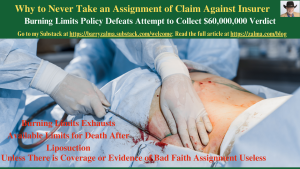Why to Never Take an Assignment of Claim Against Insurer

Post 4735
See the full video at https://rumble.com/v4dkqr9-why-to-never-take-an-assignment-of-claim-against-insurer.html and at https://youtu.be/nIsplGAO1LM
Unless There is Coverage or Evidence of Bad Faith Assignment Useless
FACTUAL BACKGROUND
In Kevin Julmist, et al v. Prime Insurance Co., et al, No. 22-10614, United States Court of Appeals, Eleventh Circuit (February 8, 2024) established that death of two liposuction patients were unable to collect any of the judgments over $60 Million because the policy protecting the doctors had a $50,000 burning limits per person policy limit and a $100,000 burning limit aggregate. The insurer refused to pay after expending its full $100,000 in defense and expense costs.
The insurance case grew out of tort claims after Dr. Nedra Dodds performed a surgical liposuction procedure on April Jenkins at CJL Healthcare, LLC (the Clinic) in Georgia. Jenkins died that same day. Four months after her death, on June 20, 2013 at the same clinic, Dr. Dodds performed a surgical liposuction procedure on Erica Beaubrun, who died that night.
The current case arises from the Clinic’s assignment to the Beaubrun estate of some of the Clinic’s claims against its insurance companies after a consent judgment in the amount of $60,000,000 was entered in favor of the Beaubrun estate and against the Clinic in the estate’s lawsuit.
The Eleventh Circuit found that the bottom line for this appeal is that under the terms of the policy, the defense of the Jenkins and the Beaubrun estates’ lawsuits exhausted the Clinic’s insurance coverage.
The Jenkins estate rejected an offer for the limits available. Prime notified the Clinic that the policy’s Professional Liability Limit of $50,000 for a single claim had been depleted defending the Jenkins estate lawsuit. Dodds was dismissed as a party, and the Jenkins estate’s case proceeded to trial, during which the Clinic was not represented by counsel. A default judgment was entered against the Clinic, and in December 2018 a jury awarded the Jenkins estate $60,000,000 in damages.
Similarly the Beaubrun estate rejected Prime’s $50,000 offer and sued. Prime’s letter to Dodds and the Clinic stated that the $50,000 “per claim limit of liability” had already been “completely depleted” in providing a defense in the Beaubrun “matter.” It added that the $50,000 per claim limit had also been expended “in relation to the claims of the Jenkins estate against the defendants. Prime withdrew its defense in the Beaubrun “matter” since the aggregate limit had been exhausted.
The Claims in the Present Lawsuit
In their complaint, the Beaubrun estate and the Clinic asserted the following claims against the defendants: Count 1 breach of duty against Claims Direct; Count 2 breach of contract against Prime; Count 3 negligence against Prime and Claims Direct; (the complaint has no Count 4); and Count 5 unauthorized sale of surplus lines insurance against Prime and Evolution. Counts 6 and 7 sought punitive damages and attorney’s fees against all the defendants.
DISCUSSION
The Limits of Liability section in the policy states that “[e]ach Wrongful Act Limit of Liability listed on the Declarations is the most we will pay for any combination of Damages and/or Claim Expenses because of all Damages arising or allegedly arising out of any one Wrongful Act.” The policy also caps payouts on multiple claims against the insured and “[n]otwithstanding anything contained in this Policy to the contrary, the Insurer’s financial obligation imposed by the coverage with respect to all Claims hereunder shall not exceed the amount specified on the Declarations as the aggregate Limit of Liability.” That’s a $100,000 cap on coverage for “all Claims.”
According to the policy’s plain terms, claim expenses come out of the policy’s limits. The policy defines “Claim Expenses” to include “[a]ll fees, costs, and expenses charged by any lawyer or other service provider designated by the Insurer to represent the Insured” and “[a]ll other fees, costs, and expenses . . . resulting from the investigation, adjustment, defense, and appeal of a Claim.” It sets the “Limit(s) of Liability” as the “maximum amount the Insurer will be obligated to pay for an otherwise covered Claim, including payment for Claim Expenses, Damages, or any other sums due under this Policy, the amount of which is set forth on the Declarations.” And “[a]ll Claim Expenses reduce the available Policy Limits.”
The district court was correct.
Burning limits policies were created to allow the insurer to know the exact amount it will need to pay in the event of catastrophic losses. Prime Insurance set a professional liability limit of $50,000 per occurrence and $100,000 in the aggregate – an obviously too small limit for the exposures faced by the doctor and the clinic. When the insurer exhausted the available limits it denied all further coverage and regardless of the judgments obtained in state court the Eleventh Circuit applied the contract terms and found that the insurer properly refused to pay more than the limit. Bad facts often make bad law but in this case the law was applied as the policy was written and made good law applying the contract as written. Why a medical practice would buy insurance with such small limits was suicidal.
 (c) 2024 Barry Zalma & ClaimSchool, Inc.
(c) 2024 Barry Zalma & ClaimSchool, Inc.
Please tell your friends and colleagues about this blog and the videos and let them subscribe to the blog and the videos.
Subscribe to my substack at https://barryzalma.substack.com/publish/post/107007808
Go to Newsbreak.com https://www.newsbreak.com/@c/1653419?s=01
Go to X @bzalma; Go to the podcast Zalma On Insurance at https://podcasters.spotify.com/pod/show/barry-zalma/support; Go to Barry Zalma videos at Rumble.com at https://rumble.com/c/c-262921; Go to Barry Zalma on YouTube- https://www.youtube.com/channel/UCysiZklEtxZsSF9DfC0Expg; Go to the Insurance Claims Library – http://zalma.com/blog/insurance-claims-library.
Like this:
Loading…







